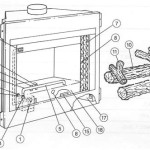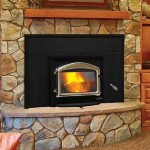Vented Propane Fireplaces: A Comprehensive Guide
Vented propane fireplaces offer a convenient and aesthetically pleasing heating solution for homes. These fireplaces, unlike their ventless counterparts, require a chimney or vent to exhaust combustion byproducts outside the dwelling. This venting system plays a crucial role in maintaining indoor air quality and ensuring safe operation.
Propane, a liquefied petroleum gas (LPG), serves as the fuel source for these fireplaces. It is a readily available and relatively clean-burning fuel, making it a popular choice for supplemental heating. The vented design allows for realistic flame patterns and higher BTU output compared to ventless models, enhancing both the visual appeal and heating capability. The following sections will explore the key aspects of vented propane fireplaces, encompassing their advantages, installation considerations, maintenance requirements, and safety precautions.
Key Features and Benefits of Vented Propane Fireplaces
Vented propane fireplaces possess several features that contribute to their popularity among homeowners. The most significant advantage lies in their ability to maintain superior indoor air quality. Because combustion gases are directed outside through the venting system, there is a minimal risk of carbon monoxide buildup or other harmful pollutants entering the living space. This is a primary safety concern addressed by the vented design.
Another key benefit is the realistic flame appearance. Vented fireplaces typically utilize larger burners and more sophisticated log sets, resulting in a more authentic and visually appealing fire. This enhances the ambiance of the room, creating a cozy and inviting atmosphere. Many models also offer adjustable flame heights and variable heat output, allowing users to customize the fireplace to their specific needs and preferences.
Furthermore, vented propane fireplaces often boast a higher BTU (British Thermal Unit) output than ventless models. BTU is a measure of heat output; the higher the BTU, the greater the heating capacity. This makes vented fireplaces suitable for heating larger areas or providing significant supplemental heat during colder months. They can efficiently and effectively warm a room, reducing reliance on central heating systems and potentially lowering energy costs.
Finally, vented propane fireplaces offer a wider range of design options. They are available in various styles, from traditional to contemporary, and can be customized to complement any décor. This versatility makes them a suitable choice for a variety of architectural styles and personal preferences. Different mantel designs, log sets, and firebox finishes allow homeowners to create a unique and personalized focal point in their living space.
Installation Requirements and Considerations
The installation of a vented propane fireplace is a more complex process than that of a ventless unit, primarily due to the venting system. Proper installation is critical to ensuring safe and efficient operation. It is strongly recommended that a qualified and licensed professional handle the installation to ensure compliance with local building codes and safety regulations.
One of the initial considerations is the availability of a suitable venting system. A traditional chimney can be used if it meets the manufacturer's specifications and is in good working order. Alternatively, a direct vent system can be installed, which vents directly through an exterior wall. Direct vent systems offer greater flexibility in placement as they do not require an existing chimney. The type of venting system selected will influence the fireplace's location and the overall cost of installation.
The propane gas line connection is another essential aspect of the installation process. A dedicated gas line must be run from the propane tank or supply line to the fireplace location. This work should only be performed by a qualified gas fitter to ensure a secure and leak-free connection. Local codes often dictate the type of piping and fittings required for propane gas lines, and adherence to these codes is paramount for safety.
Furthermore, proper clearances from combustible materials must be maintained during installation. The fireplace manufacturer's instructions will specify the minimum distances required between the fireplace and any surrounding walls, floors, or furniture. Failure to adhere to these clearances can pose a fire hazard. Heat shields may be necessary in some installations to further protect combustible materials.
Finally, a thorough inspection of the completed installation is crucial. This should include checking for gas leaks, verifying the proper operation of the venting system, and ensuring that all safety features are functioning correctly. A professional installer will typically perform these checks as part of the installation process. Post-installation, it’s recommended to obtain verification from the installer and possibly the local municipality to ensure compliance and safety.
Maintenance and Safety Procedures
Regular maintenance is essential for ensuring the safe and efficient operation of a vented propane fireplace. A well-maintained fireplace will not only provide reliable heating but also minimize the risk of safety hazards. The maintenance schedule should include both routine tasks and more thorough inspections performed by a qualified technician.
One of the most important routine maintenance tasks is cleaning the fireplace. This involves removing any dust, debris, or soot that may have accumulated on the burner, logs, or firebox. A soft brush or vacuum cleaner can be used for this purpose. Cleaning helps to prevent clogs and ensures proper airflow, which is essential for efficient combustion. Follow the manufacturer’s guidelines carefully. Incorrect cleaning methods can damage the components.
The venting system should also be inspected regularly for any obstructions or damage. Birds' nests, leaves, or other debris can block the vent, preventing proper exhaust of combustion gases. A visual inspection of the vent terminal can often reveal any obvious obstructions. If a blockage is suspected, a professional chimney sweep should be consulted to clear the vent. A damaged vent should be repaired or replaced immediately to prevent leaks or carbon monoxide buildup.
In addition to routine cleaning and inspection, a professional service should be performed annually. A qualified technician will inspect the gas line connections, burner assembly, pilot light, and control valves. They will also check for any leaks or signs of wear and tear. This annual service helps to identify and address potential problems before they become serious safety hazards. It is especially important to ensure the proper functioning of the safety shut-off mechanisms.
Carbon monoxide detectors are a vital safety measure for any home with a fuel-burning appliance, including a vented propane fireplace. These detectors should be installed in accordance with the manufacturer's instructions and tested regularly. Carbon monoxide is a colorless, odorless gas that can be deadly. A working carbon monoxide detector can provide an early warning of a leak, allowing occupants to evacuate the premises and seek medical attention.
Finally, users should be aware of the symptoms of carbon monoxide poisoning, which can include headache, dizziness, nausea, and confusion. If any of these symptoms are experienced, it is important to immediately evacuate the premises and seek medical attention. Do not return to the building until it has been inspected and cleared by a qualified professional. Staying vigilant regarding safety precautions will maximize the use and enjoyment of a vented propane fireplace.

Benefits Of Direct Vent Fireplaces
Understanding How Direct Vent Works Heat Glo

Empire Dvp42fp31n Tahoe Premium Direct Vent Fireplace

Freestanding High Efficiency Direct Vent Gas Fireplaces Inserts Stoves Godby Hearth And Home

Napoleon Ascent Dx42 Direct Vent Gas Burning Fireplace

Direct Vent Gas Stoves In Dc

Free Standing Gas Fireplace Stoves For 30 On Now

What Are The Best Ways To Vent A Gas Fireplace Zoroast

Vented Vs B Vent Direct Free Dixie S

What Are Direct Vent Gas Fireplaces Admiral Propane
Related Posts








